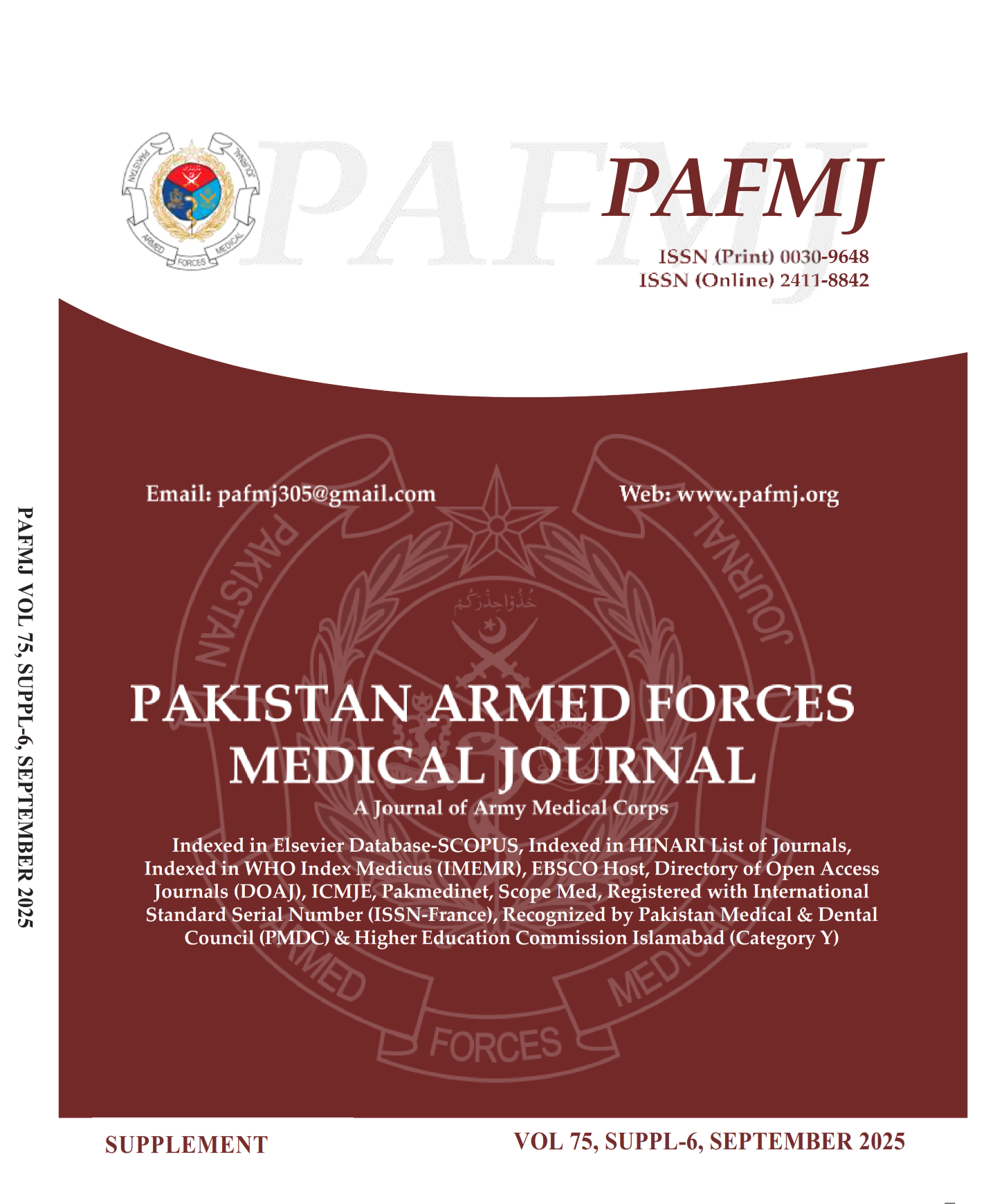Early Neuromuscular Blockade in the Acute Respiratory Distress Syndrome
DOI:
https://doi.org/10.51253/pafmj.v75iSUPPL-6.7686Keywords:
Acute Respiratory Distress Syndrome, Cisatracurium, MortalityAbstract
Objective: To assess the role of early neuromuscular blockade in the acute respiratory distress syndrome among patients managed in Critical Care Unit.
Study Design: Comparative Cross-sectional Study.
Setting and Duration of Study: Critical Care Unit, Pakistan Navy Station Shifa Hospital, Karachi Pakistan, from Oct 2019 to Oct 2021.
Methodology: Patients diagnosed with moderate or severe acute respiratory distress syndrome by consultant critical care physician and admitted in critical care unit were included in the study. They were randomly divided in to two groups. Group A received cisatracurium infusion for 48 hours in addition to treatment as usual while group B just received treatment as usual. Ninety days’ mortality was assessed in all the patients and use of early neuromuscular blockade along with other factors were associated with mortality among the study participants.
Results: A total of 280 patients were admitted in the intensive care unit with moderate to severe Acute respiratory distress syndrome during the study period. Out of them 200(71.4%) were male while 80(28.6%) were female. 159(56.8%) patients survived within 90 days of admission while 121(43.2%) died within those 90 days. Use of early neuromuscular blockage had no statistically significant relationship (p-value-0.848) with 90 days’ mortality in our study participants.
Conclusion: Mortality rate was more than 40% in patients suffering from moderate to severe acute respiratory distress syndrome in our data set. Use of early neuromuscular blockage did not provide any added benefit in reduction of mortality in patients studied for two years in our critical care unit.
Downloads
References
1. Hashmi M, Taqi A, Memon MI, Ali SM, Khaskheli S, Sheharyar M et al. A national survey of critical care services in hospitals accredited for training in a lower-middle income country: Pakistan. J Crit Care 2020; 60(3): 273-278.
https://doi.org/10.1016/j.jcrc.2020.08.017
2. Kiehl MG, Beutel G, Böll B, Buchheidt D, Forkert R, Fuhrmann V, et al. Consensus statement for cancer patients requiring intensive care support. Ann Hematol 2018; 97(7): 1271-1282.
https://doi.org/10.1007/s00277-018-3312-y
3. Netzer G, Liu X, Shanholtz C, Harris A, Verceles A, Iwashyna TJ. Decreased mortality resulting from a multicomponent intervention in a tertiary care medical intensive care unit. Crit Care Med 2011; 39(2): 284-293.
https://doi.org/10.1097/CCM.0b013e3181ffdd2f
4. Rezoagli E, Fumagalli R, Bellani G. Definition and epidemiology of acute respiratory distress syndrome. Ann Transl Med 2017; 5(14): 282.
https://doi.org/10.21037/atm.2017.06.62
5. Fan E, Brodie D, Slutsky AS. Acute Respiratory Distress Syndrome: Advances in Diagnosis and Treatment. JAMA 2018; 319(7): 698-710.
https://doi.org/10.1001/jama.2017.21907
6. Slutsky AS, Villar J. Early Paralytic Agents for ARDS? Yes, No, and Sometimes. N Engl J Med 2019; 380(21): 2061-2063.
https://doi.org/10.1056/NEJMe1905627
7. Moss M, Huang DT, Brower RG, Ferguson ND, Ginde AA, et al. Early Neuromuscular Blockade in the Acute Respiratory Distress Syndrome. N Engl J Med 2019; 380(21): 1997-2008.
https://doi.org/10.1056/NEJMoa1901686
8. De Souza GM, Vianna FSL, Midega TD, Serpa Neto A. Probability of benefit with the use of neuromuscular blockade in patients with acute respiratory distress syndrome. J Thorac Dis 2019; 11(9): 3676-3680.
https://doi.org/10.21037/jtd.2019.09.26
9. Papazian L, Forel JM, Gacouin A, Penot-Ragon C, Perrin G, Loundou A, et al. Neuromuscular blockers in early acute respiratory distress syndrome. N Engl J Med 2010; 363(12): 1107-1116.
https://doi.org/10.1056/NEJMoa1005372
10. Hussain SF, Irfan M, Naqi YS, Islam M, Akhtar W. Acute respiratory failure in Pakistani patients: risk factors associated with mortality. J Coll Physicians Surg Pak 2006; 16(4): 287-290.
11. Cochi SE, Kempker JA, Annangi S, Kramer MR, Martin GS. Mortality Trends of Acute Respiratory Distress Syndrome in the United States from 1999 to 2013. Ann Am Thorac Soc 2016; 13(10): 1742-1751.
https://doi.org/10.1513/AnnalsATS.201512-841OC
12. Chiumello D, Marino A, Cammaroto A. The Acute Respiratory Distress Syndrome: Diagnosis and Management. Practical Trends in Anesthesia and Intensive Care 2018; 189-204.
https://doi.org/10.1007/978-3-319-94189-9_11
13. Matthay MA, Zemans RL, Zimmerman GA, Arabi YM, Beitler JR, Mercat Aet al. Acute respiratory distress syndrome. Nat Rev Dis Primers 2019; 5(1): 18.
https://doi.org/10.1038/s41572-019-0069-0
14. Forel JM, Roch A, Marin V, et al. Neuromuscular blocking agents decrease inflammatory response in patients presenting with acute respiratory distress syndrome. Crit Care Med 2006; 34(3): 2749-2757.
15. Ho ATN, Patolia S, Guervilly, C. Neuromuscular blockade in acute respiratory distress syndrome: a systematic review and meta-analysis of randomized controlled trials. J intensive care 2020; 12(1): 12.
https://doi.org/10.1186/s40560-020-0431-z
16. Wongtangman K, Grabitz SD, Hammer M, Wachtendorf LJ, Xu X, Schaefer MS, et al. Optimal Sedation in Patients Who Receive Neuromuscular Blocking Agent Infusions for Treatment of Acute Respiratory Distress Syndrome-A Retrospective Cohort Study From a New England Health Care Network. Crit Care Med 2021; 49(7): 1137-1148.
https://doi.org/10.1097/CCM.0000000000004951
17. Needham CJ, Brindley PG. Best evidence in critical care medicine: The role of neuromuscular blocking drugs in early severe acute respiratory distress syndrome. Can J Anaesth 2012; 59(1): 105-108.
https://doi.org/10.1007/s12630-011-9615-2
18. Alhazzani W, Alshahrani M, Jaeschke R, Forel JM, Papazian L, Sevransky J, et al. Neuromuscular blocking agents in acute respiratory distress syndrome: a systematic review and meta-analysis of randomized controlled trials. Crit Care 2013; 17(2): R43. https://doi.org/10.1186/cc12557
Downloads
Published
Issue
Section
License
Copyright (c) 2025 Kazi Iftikhar Qureshi, Tariq Mahmood, Ali Aftab, Ahmed Mujadid Burki, Hatim Saifee, Reema Iftikhar

This work is licensed under a Creative Commons Attribution-NonCommercial 4.0 International License.















